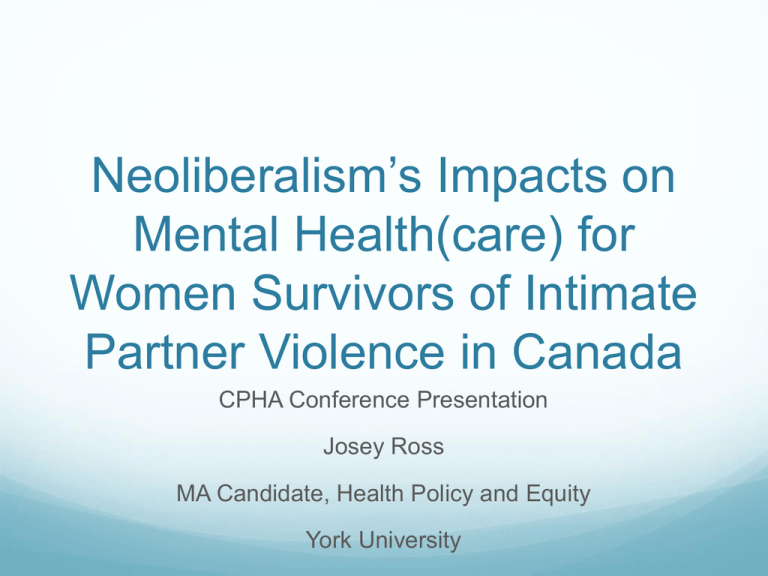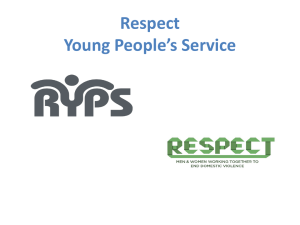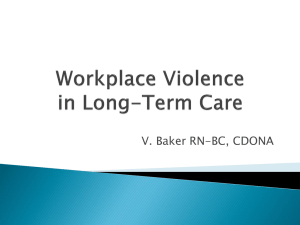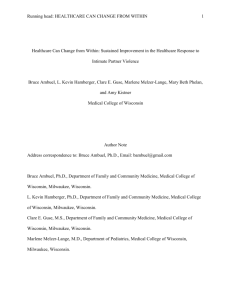Presentation - Canadian Public Health Association
advertisement

Neoliberalism’s Impacts on Mental Health(care) for Women Survivors of Intimate Partner Violence in Canada CPHA Conference Presentation Josey Ross MA Candidate, Health Policy and Equity York University Background At least 1 in 4 Women in Canada will experience intimate partner or sexualized violence in her lifetime (McInturff, 2013). Victims of IPV experience short- and long-term impacts ranging from injuries and mental health problems to lost education opportunities and poverty (McInturff, 2013). IPV associated with PTSD, depression, eating disorders, personality disorders and suicidality (WHO, 2013; Morrow, 2002, p 18) Funding cutbacks and narrowing mandates of anti-violence and mental healthcare services for survivors (Collier, 2009; Morrow, 2002) Why This Topic? Literature exists on: IPV and mental health Neoliberalism and public policy Neoliberalization of anti-violence work Neoliberalization of mental healthcare Gendered nature of mental healthcare No literature exists examining impacts of neoliberal policymaking on mental health of women survivors of intimate partner violence Impacts of Violence in Canada Estimated $9 billion annually (McInturff, 2013) Higher healthcare utilization of IPV survivors than general population (Varcoe et al., 2001) Mental health impacts (BCMOH, 2012) Differential rates of violence experienced by women experiencing multiple sites of marginalization (BCMOH, 2012) What is Neoliberalism? “A deliberate push for an emphasis on individualism, and on consumption as a source of identity and a vehicle for social participation” (Coulter, 2009, p. 26) “A movement away from a social state and redistributive policies towards government that focuses less on social programs…and more on optimizing conditions for market activity and capital accumulation” (Coulter, 2009, p. 26) Neoliberalism and Public Policy Privatization of services (Coulter, 2009) Delisting of services (Coulter, 2009) Public-private partnership arrangements (Coulter, 2009) Promotion and celebration of volunteerism, charity, or fundraising as a substitution for public investment (Coulter, 2009) Barriers to Leaving Isolation, institutional failure, systemic barriers (Moe, 2007) Substance abuse issues, lack of safe housing, lack of transportation (Zweig, Schlicter, and Burt, 2002) Fear of retaliation and stalking (Alabama Coalition, n.d.) Cuts to social assistance, disability pensions, EI, public housing (Braedley, 2007) Neoliberalization of AntiViolence Work Conservative and Liberal governments cut funding to anti-violence programs (Collier, 2009) Dismantling of programs fighting for women’s equality (Beres, et al., 2009) Discursive reconfiguration of IPV as private, random, and individual (Beres, et al., 2009) Dominance of managerialist outcome measures (McDonald, 2005) Applying a Gendered Lens to Mental Healthcare Women’s mental health impacted and shaped by social inequities (Morrow and Chappell, 1999) Certain types of mental health issues linked to IPV (Morrow and Chappell, 1999) Mainstreaming (Humphreys, 2008) Neoliberalization of Mental Healthcare Shift from federal to provincial responsibility (Carney, 2000) Reliance on private sector providers and funding (Carney, 2000) Adaption of corporate management practices (Teghtsoonian, 2009) Focus on measurable outcomes (Morrow, 2002) Impacts of Neoliberalism on Survivors of IPV No existing literature Increased barriers to leaving abusive relationship Cuts to women’s services Narrowly-focused mental health services Conclusion Neoliberal policies have had deleterious affects on: Woman-serving agencies Mental healthcare provision and access Social determinants of mental health Women survivors of IPV Next steps: Quantitative and qualitative research examining further the impacts of neoliberalism on women survivors of IPV living with mental health problems References Alabama Coalition Against Domestic Violence. (No date given). Barriers to leaving. Retrieved from http://www.acadv.org/barriers.html. British Columbia. Ministry of Health. Healthy Women, Children and Youth Secretariat. (2012) A framework for addressing violence against women in relationships: A supplement to the public health core program on prevention of violence, abuse and neglect. Retrieved from Ministry of Health website: http://www.health.gov.bc.ca/women-and-children/pdf/addressing-violencewomen-in-relationship.pdf Beres, M.A., Crow, B. & Gotell, L. (2009). The perils of institutionalization in neoliberal times: Results of a national survey of Canadian sexual assault and rape crisis centres. Canadian Journal of Sociology, 34(1): 135-163. Braedley, S. (2007). “Accidental” health care: Masculinity and neoliberalism at work. In Braedley, S. & Luxton, M. (ed) Neoliberalism and everyday life. Montreal: MQUP. Carney, T. (2008). The mental health service crisis of neoliberalism—An antipodean perspective. International Journal of Law and Psychiatry 31: 101115. References Cont’d Collier, C. (2009). Violence against women or violence against ‘people’? Assessing the impact of neoliberalism and post-neoliberalism on anti-violence policy in Ontario and British Columbia. In Alexandra Dobrowolsky (ed.), Women and Public Policy in Canada Today: Neoliberalism and After? Toronto: Oxford University Press. Coulter, K. (2009). Women, poverty policy, and the production of neoliberal politics in Ontario, Canada. Journal of Women, Politics & Policy 30(1): 23-45. DOI: 10.1080/15544770802367788 Humphreys, C. (2008). Responding to the individual trauma of domestic violence: Challenges for mental health professionals. Social Work in Mental Health 7 (1-3): 186203. doi:10.1080/15332980802072546 McDonald, J. (2005). Neo-liberalism and the pathologising of public issues: The displacement of feminist service models in domestic violence support services. Australian Social Work, 58(3): 275-284. doi: http://dx.doi.org/10.1111/j.14470748.2005.00220.x McInturff, K. (2013). The gap in the gender gap: Violence against women in Canada. Retrieved from Canadian Centre for Policy Alternatives website: http://www.policyalternatives.ca/publications/reports/gap-gender-gap Moe, A. M. (2007). Silenced voices and structured survival: Battered women’s help seeking. Violence Against Women 13(7): 676-699. References Cont’d Morrow, M. (2002). Violence and trauma in the lives of women with serious mental illness: Current practices in service provision in British Columbia. Retrieved from British Columbia Centre of Excellence for Women’s Health website: bccewh.bc.ca/publicationsresources/documents/violencetrauma.pdf Morrow, M. and Chappell, M. (1999). Hearing women’s voices: Mental health care for women. Retrieved from British Columbia Centre of Excellence for Women’s Health website: bccewh.bc.ca/publications-resources/documents/hearingvoices.pdf Teghtsoonian, K. (2009). Depression and mental health in neoliberal times: A critical analysis of policy and discourse. Social Science & Medicine 69: 28-35. Varcoe, C., Hankivsky, O., Ford-Gilboe, M., Wuest, J., Wilk, P., Hammerton, J. & Campbell, J. (2011). Attributing selected costs to intimate partner violence in a sample of women who have left abusive partners: A social determinants of health approach. Canadian Public Policy: 37(3): 359-380. World Health Organization. (2013). Violence Against Women. Retrieved from: http://www.who.int/mediacentre/factsheets/fs239/en/ Zweig, J. M., Schlichter, K. A., & Burt, M. R. (2002). Assisting women victims of violence who experience multiple barriers to services. Violence Against Women 8(2): 162-180. Questions? Contact me at rossjwg@yorku.ca











